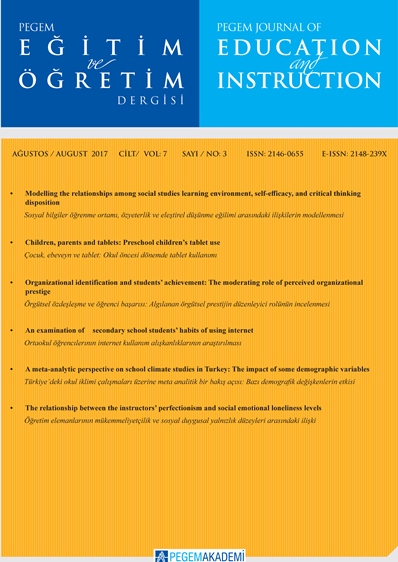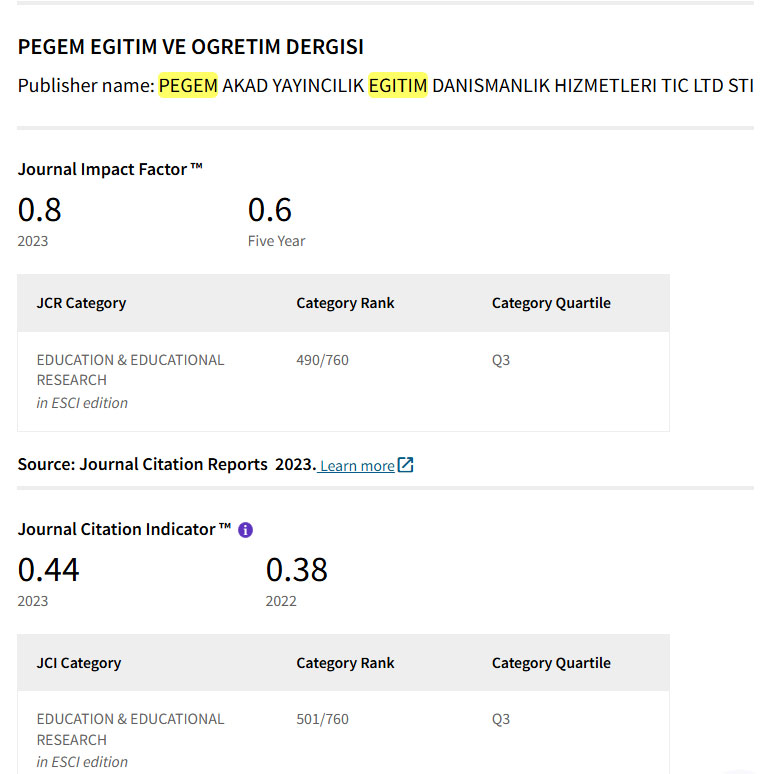Determining the effectiveness of pre-university student’s online learning in geography subject using relative importance index
English
DOI:
https://doi.org/10.47750/pegegog.11.04.15Keywords:
effectiveness and achievement, online learning, Relative Importance Index (RII), interest, acceptanceAbstract
This study aims to examine the Relative Importance Index (RII) that influences online learning in the subject of Geography. This study is a survey study involving five secondary schools in the state of Perak, Malaysia consisted of 135 form six students selected by simple random sampling. Data were collected through a questionnaire containing 45 items to measure interest, acceptance, and effectiveness. The collected data were analyzed via SPSS software using descriptive analysis and RII analysis. Findings of the study for RII show that ‘when learning there is an interesting video display’ has the highest RII value (RII = 0.8933), while ‘I prefer to learn through the internet because any time I can learn’ contributes the second highest RII value (RII = 0.8296) for the factor acceptance criteria. For the learning effectiveness criteria, the ‘online learning factor created curiosity to me in the subject of Geography’ has the highest RII value (RII = 0.8281). Finally, for the achievement criteria, the factor of ‘understanding the important contents in learning through attractive colors and graphics contributes the highest RII value (RII = 0.8207). On average, the RII value of the interest criterion was in the highest position (RII = 0.8076), followed by the achievement criterion (RII = 0.7684). Meanwhile, the learning effectiveness criteria were in the lowest position (RII = 0.7516) of the overall study criteria. The conclusion from this study shows that the criteria of interest and achievement are the main factors of online learning choices of form six Geography students.
Downloads
References
Abdullah, I. (2004). Pembelajaran berpusatkan pelajar dan kaitannya dengan pembangunan diri dan peluang pekerjaan. Published in Proceedings of the Seminar Penyelidikan Pendidikan Guru Peringkat Kebangsaan. Langkawi, Malaysia. [In Malay]
Abdul Said, A., Baharom, M., Mohd Yusof, A., Mohamad Johdi, S., & Nelly, F. (2011). Keberkesanan penggunaan model bentuk muka bumi sungai bagi meningkatkan prestasi pelajar dalam mata pelajaran Geografi Tingkatan 1. National Seminar on History and Geography Education. Organiser & Venue: Universiti Malaysia Sabah, Kota Kinabalu, on 13 - 14 July 2011, (July), 1–12. Retrieved from http://irep.iium.edu.my/30709/. [In Malay]
Akadiri O.P., (2011), Development of a Multi-Criteria Approach for the Selection of Sustainable Materials for Building Projects, PhD Thesis, University of Wolverhampton, Wolverhampton, UK.
Che Ghani, C. K., Mai Shihah, A., Arasinah, K., Zaliza, H., & Ridzuan, C. (2016). Amalan gaya pembelajaran pelajar cemerlang di Politeknik Seberang Perai: Kajian pelajar Malaysia berdasarkan model Felder Silvermen. Geografia: Malaysian Journal of Society and Space, 12 (3), 181-191. [In Malay]
Chyun, L.T. (2007). Hubungan antara pendekatan pengajaran guru dengan pendekatan pembelajaran pelajar mata pelajaran kimia tingkatan empat. Master Dissertation, Universiti Teknologi Malaysia, Malaysia. [In Malay]
Faizah, J. (2017). Bahan bantu mengajar (BBM) dalam pengajaran dan pembelajaran (P&P) di Sekolah Menengah Kebangsaan (SMK) Daerah Pontian. Retrieved from http://eprints.uthm.edu.my/9573/1/FAIZAH_JA’APAR.pdf. [In Malay]
Faizatul Hafilah, A. H., & Nor Syahilia, A. (2010). Persepsi pelajar terhadap pembelajaran teradun (Blended learning). Journal of Technical and Vocational Education, 1(2), 53–62. [In Malay]
Fazurawati, C. L. (2020, April 13). Pastikan pelajar tidak ketinggalan. MyMetro. Retrieved from www.hmetro.com.my/akademik/2020/04/565801/pastikan-pelajar-tak-ketinggalan. [In Malay]
Felder R. M., Silverman L. K. (1988). Learning and teaching styles in engineering education. Journal of Engineering Education, 78 (7), 674-681.
Feng, G., Lane, J., Stoltman, P. J., Khlebosolova, O., Hao, L., & Weiguo, Z. (2018). Sustainable development in geography education for middle school in China. Sustainability, 10 (11), 1-27.
Guzman, M., Olaguer, D. L., & Novera, G. (2017). Difficulties faced in teaching Geography lessons at public secondary school’s division of Zambales, Philippines. IOSR Journal of Humanities and Social Science, 22 (9), 64-70.
Habibah, l., Arumugam, R., & Teoh, A. N. (2004). Penggunaan multimedia interaktif dalam pembelajaran Geografi di persekolahan. Persidangan Pendidikan Geografi Kebangsaan (11), 2 (2), 1-17. [In Malay]
Herman, D. S. (2015). The effects of multimedia and learning style on student achievement in online electronics course. Turkish Online Journal of Educational Technology-TOJET, 14 (1), 116-122.
Huba, M. E. & Freed, J. E. (2000). Learner centered assessment on college campuses: Shifting the focus from teaching to learning. Community College Journal of Research and Practice. 24 (9), 759-766.
Iberahim, A. R., Mahamod, Z., & Mohamad, W. M. R. W. (2017). Pembelajaran Abad Ke-21 Dan Pengaruhnya Terhadap Sikap, Motivasi dan Pencapaian Bahasa Melayu Pelajar Sekolah Menengah. Jurnal Pendidikan Bahasa Melayu –JPBM (Malay Language Education Journal–MyLEJ), 7(2), 77-88. [In Malay]
Kocalar, A., & Demikaya, H. (2017). Geography teachers’ views on effective Geography teaching. Review of International Geographical Education Online, 7(3), 332-346.
Krejcie, R.V., & Morgan, D. W. (1970). Determining sample size for research activities. Education and Psychological Measurement, 30, 607-610.
Masyuniza, Y. (2015). Hubungan sikap dan persepsi murid terhadap pembelajaran Bahasa Melayu dengan kemahiran abad ke-21. Jurnal Pendidikan Bahasa Melayu – JPBM, 5(2), 22-30. [In Malay]
Mayer, E. R. (2014). Cognitive theory of multimedia learning. In M. Richard E. (Ed.). The Cambridge handbook of multimedia learning (2nd ed, pp. 44-71). United Kingdom: Cambridge University Press.
Md Zuki, N.S. & Khalid. (2016). Penggunaan Web 2.0 dalam Pendidikan Abad ke-21 dalam Nabilah Othman, Chiang Wei Luan &Nurul Syaida Md Zuki. (Ed), Pendidikan Abad ke-21: Peranan Teknologi Maklumat dan Komunikasi serta Cabarannya. Fakulti Pendidikan UKM, Bangi. [In Malay]
Mohammad Zohir, A. (2016). Pendidikan geografi di sekolah-sekolah Malaysia: Perkembangan dan isu. Geografi, 4 (1), 1-10.
Mohd Faizal, M. (2012). Faktor yang berkaitan dengan pencapaian Matematik pelajar Melayu Sekolah Menengah Agama Daerah Pontian. (Tesis master). Retrieved from http://eprints.utm.my/id/eprint/32080. [In Malay]
Muhammad Sukri, S., Mohd Anuar, A. R., & Ting, K. S. (2007). Kajian mengenai penggunaan e-pembelajaran (e-learning) di kalangan pelajar jurusan pendidikan teknikal dan vokasional di institusi pengajian tinggi (ipta) negeri Johor. International Malaysian Educational Technology Convention. [In Malay]
Nor Zaira, R., Zolkefli, B., & Mohd Kasri, S. (2016). Faktor-faktor yang mempengaruhi penggunaan VLE Frog dalam kalangan guru di sekolah menengah. 1(October), 1023–1032. [In Malay]
Norah, M. N., Nurul Izzati, H. & Radhiah, A. R. (2013). The framework for learning using video based on cognitive load theory among visual learners. Published in Proceedings of the 5th Conference on Engineering Education. pp. 15-20.
Norazlina, A., & Abdul, R. I. (2013). Penggunaan internet dalam kalangan guru-guru sekolah rendah di sekitar Johor Bahru, Johor. 1–8. Retrieved from http://eprints.utm.my/11475/1/Penggunaan_Internet_Dalam_Kalangan_Guru.pdf. [In Malay]
Norfadzilah,M. (2016). Pelaksanaan pembelajaran melalui Curriculum Information Document Online System (CIDOS) dalam memperkasakan pengajaran pensyarah di Politeknik. (Degree Thesis). [In Malay]
Norfarahi, Z., Mohd Isa, H., & Khadijah, A. R. (2020). Isu dan cabaran penggunaan MOOC dalam proses pengajaran dan pembelajaran. Journal of Research, Policy & Practice of Teachers & Teacher Education, 10 (1), 1-18. [In Malay]
Nurul Nashrah, S., Noor Hasimah, H., & Nur Aida, A. H. (2015). Matematik dan kemahiran abad ke-21: Perspektif pelajar. Jurnal Pendidikan Matematik, 3(1), 24-36. Retrieved from http://journalarticle.ukm.my/. [In Malay]
Pablo, F. J., Esperanza, S. R., & Stephen, B. l. (2019). Improving the learning processes of Physical Geography through the use of landscape photographs in class. Journal of Geography in Higher Education, 43 (1), 24–39. https://doi.org/10.1080/03098265.2018.1515189.
Rian, V. & Osman, K. (2013). Keberkesanan penggunaan pelbagai media pengajaran dalam meningkatkan kemahiran proses sains dalam kalangan pelajar. Jurnal Pendidikan Malaysia, 37(1), 1-11. [In Malay]
Shahfiezul Shahaimi & Fariza Khalid. (2015). Persekitaran Pembelajaran Maya Frog (VLEFROG) di sekolah-sekolah di Malaysia: Pelaksanaan dan cabaran. Dlm. Prosiding Seminar Kebangsaan Pendidikan Negara Kali Ke-5. [In Malay]
Shamsiah, S., & Azman, H. (2015). Kebolehan guru-guru mata pelajaran Geografi menggunakan teknologi maklumat dan komunikasi (TMK) dalam pengajaran dan pembelajaran di sekolah menengah Malaysia. Journal of Global Business and Social Entrepreneurship (GBSE), 1(2), 35–43. [In Malay]
Shephard, K. (2003). Questioning, promoting and evaluating the use of streaming video to support student learning. British Journal of Educational Technology. 34(3), 295-308.
Shouye, D. (2017). Application of multimedia technology in the cource teaching of Geography of China. In 7th International Conference on Education, Management, Computer and Society (EMCS 2017) (Vol. 61, pp. 347-351). Tonghua, Jilin: Atlantis Press.
Siti Hajar, M. N. (2015). Tahap Penggunaan multimedia di kalangan guru sains dalam pengajaran sains KBSM. Latihan Ilmiah Sarjana Muda Pendidikan Universiti Kebangsaan Malaysia. [In Malay]
Slameto. (2003). Belajar dan faktor-faktor yang mempengaruhinya. Jakarta: Rineka Cipta. [In Malay]
Smaldino, S.E., Lowther, D.L., & Russell, J.D. (2008). Instructional technology and media for learning. NJ: Pearson.
Yusup, H., Md Nor, S., Ismail, R., & Mahizer, H. (2013). Kompetensi pensyarah menggunakan pendekatan pembelajaran dalam talian (PDT) dalam sistem pembelajaran konvensional. Retrieved from https://www.researchgate.net/publication/259337692_Kompetensi_Pensyarah_Menggunakan_Pendekatan_Pembelajaran_Dalam_Talian_PDT_Dalam_Sistem_Pembelajaran_Konvesional. [In Malay]
Downloads
Published
How to Cite
Issue
Section
License
Copyright (c) 2021 Pegem Journal of Education and Instruction

This work is licensed under a Creative Commons Attribution-NonCommercial 4.0 International License.
Attribution — You must give appropriate credit, provide a link to the license, and indicate if changes were made. You may do so in any reasonable manner, but not in any way that suggests the licensor endorses you or your use.
NonCommercial — You may not use the material for commercial purposes.
No additional restrictions — You may not apply legal terms or technological measures that legally restrict others from doing anything the license permits.




